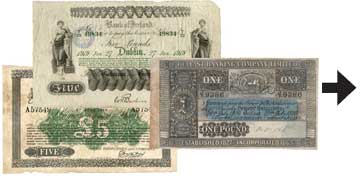

In Ireland, apart from the Bank of Ireland, all of the note-issuing public joint stock banks were founded in the few years from 1824 to 1836, after the end of an era of over a hundred years of private bank note issues. From ca1836 all banknotes circulating in Ireland were issued by six large joint stock banks, Bank of Ireland, Provincial Bank of Ireland, The National Bank, Belfast Banking Company, Northern Banking Company, and the Ulster Banking Company. The designs of their banknotes had remained largely unchanged from around 1870 to 1918.
The designs of the banknotes of Ireland underwent a radical change in the first quarter of the twentieth Century, which transformed old fashioned note designs into a more modern currency.
The paper currency circulating in Ireland simultaneously underwent two entirely different changes in the decade after World War 1. An increase in the supply of £1 notes, combined with a general modernisation of paper money resulting from inflation and new printing techniques, lead to smaller banknote sizes, printed on both sides.
Changes in legislation governing paper money in Ireland removed the requirement to state the branch of payment on a banknote and lead to the disappearance of branch listings on notes. By 1923 most of the banknote issues had been transformed greatly.
Old Notes, Time for Change
Prior to World War One, all of the bank notes in use in Ireland were large size, decades-old designs. Towards the end of the war era a modernisation of the note issues began to creep in with the Bank of Ireland reducing its £1 notes in size in January 1918, likely in response to inflation of the time and an increase in the quantities of banknotes being produced as a result. Other banks began to follow suit immediately.
In 1920 the Banknotes (Ireland) Act [7] repealed an 1828 Act requiring a bank to list the branch of issue on its notes. This lead to the removal of the branch listings on notes from the end of 1920, and precipitated the replacement of all notes in circulation.
These were the two primary factors which shaped the changes in Irish paper money up to around 1923.
Whilst £1 notes became smaller and more abundant, higher denomination notes of most banks remained large size and less common. All note issues had the listings of branches removed from the design; most came to be printed on both sides and in some cases underwent colour changes. All of this came to pass in a period of around four years, after decades of stable unchanging designs.
Political Partition Leads to Currency Changes
At the same time, the Irish war of Independence in 1919-21 lead to the creation on 6 December 1922 of the Irish Free State and Northern Ireland as separate political jurisdictions, along the boundaries of the 1921 partition of Ireland. Currency union was retained for a time, but the eventual partition of Irish currencies followed in 1929 resulting again in the replacement of almost all banknotes in circulation.
Large Size and Small Size Notes
Collectors regard the large size and small size notes with branch listings (multibranch) as being different, separate Types, and also regard small size notes with branch listings removed as being a further different Type.
The treatment by the banks of these alterations to their note issues varied. Some of the changes were treated as new issue series by some of the banks, whilst other banks treated the changed notes as continuations of an existing series. The criterion used here treats an instance where serial numbers were reset by the bank as creating a new series.
The banks approached the reduction of their £1 note sizes in different ways, as can be seen from a study of the prefixing systems. Taking the continuation of a prefixing system as the continuation of a series, some banks may be regarded as having started a new series with the reduction of their banknote note sizes, others regarding the reduction of note size as incidental, and part of a continuing series. From a collecting point of view, there were several Type changes over the period of a few years as the banks altered the design and shape of their notes.
Increased Money Supply in Ireland
As the first world war era came to an end, the number of low denomination notes in circulation saw a general increase with the sharp inflation of the time. This is reflected in the number of £1 notes being printed from around 1920 onwards, and in the extension of the serial numbers on these notes beyond 100,000 per prefix.
Differences in the evolution of serial numbers can be seen between the banks. Bank of Ireland £1 notes of the 1922–1928 series had serial numbers which ran from 000001 to 999999 per prefix, with one prefix per date, and far fewer dates than for previous series. It is likely that a 1,000,000 terminator note would have been used to complete the prefix.
The Northern and National banks printed up to 100,000 notes per £1 prefix, and the Provincial bank likely numbered its £1 notes up to 200,000 per prefix.
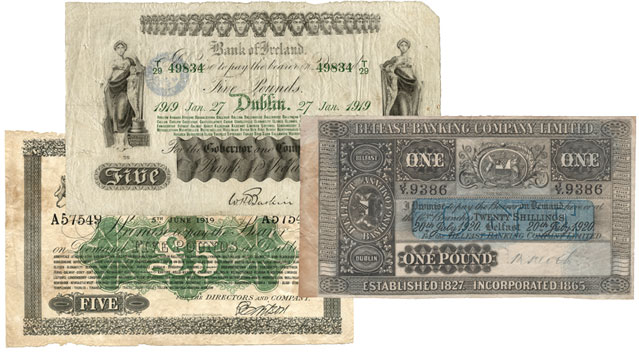
Large size banknotes with branches are produced up to 1920.
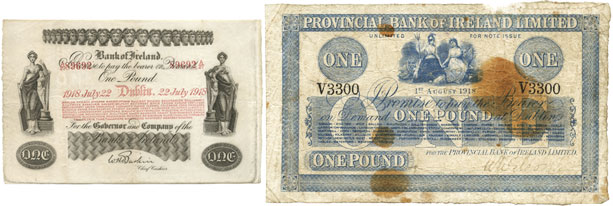
Reduced size £1 notes are introduced by Bank of Ireland and Provincial Bank of Ireland in 1918, the first in a trend towards smaller banknote sizes.

Small size notes, very similar in size to 1917 English Treasury £1 Notes, begin to be introduced by the National Bank (1918) and Provincial Bank of Ireland (1919).
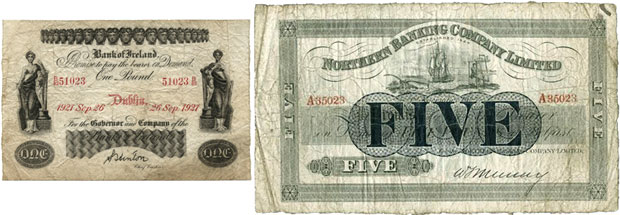
The Bank Notes (Ireland) Act 1920 removed the requirement of banks to make payment on their notes at the branch of issue. Branches are no longer listed after this, with just the head office being printed on each note.
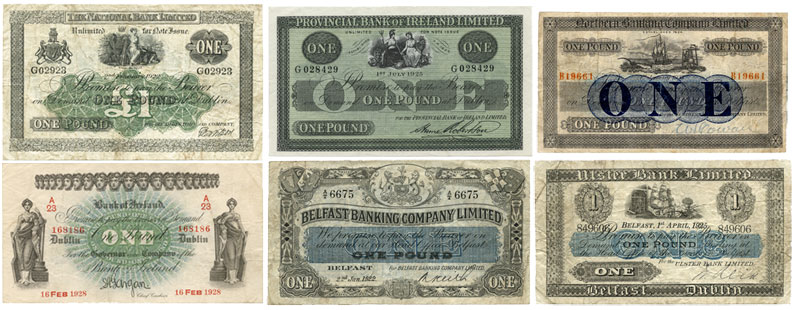
By 1922 all six Irish banks are now producing small size £1 notes. Higher denominations remain large size except for National Bank which made all of its denominations small size. Bank of Ireland and Belfast Banking Company introduce new banknote designs in 1922, with banknotes of varying sizes.
Apart from the Bank of Ireland reduced size £1 notes (Series F and G, 1918-1921) and the slightly reduced size £1 note issued by the Provincial Bank of Ireland (Series C, 1918), the first small size notes, introduced by the National Bank (Series C, 1918) and Provincial Bank of Ireland (Series D, 1919), were similar in size to the third series of English £1 Treasury Notes, 1917, which may have influenced the size used by the Irish banks for their new design of £1 notes.
This became the approximate default size used for Irish £1 notes after 1922.
It should be kept in mind that the Bank of Ireland was generally the leader in a conservative trend in Irish paper money issues. Also, the Bank of Ireland developed and printed its own notes at its premises in College Green, Dublin, whereas the other banks’ notes were printed by commercial printers in England. Thus, the base design of Bank of Ireland notes tended to differ from those of the other banks which came from a stable of stock design features, as had always been the case.
The Bank Notes (Ireland) Act came into force on 4 Aug 1920, and repealed an 1828 Act which placed an obligation on Irish banks to pay their notes on demand at the branch of issue as well as the head office. Branch listings ceased to be printed on banknotes as a result of this, with just the head office name on each note. The Northern Bank and Belfast Banks listed Belfast as head office, Ulster Bank listed Belfast & Dublin until 1925 when only Belfast was listed thereafter. The other three banks listed Dublin as head office.
Reverse side printing was introduced by several banks on their new banknote designs at this time. Higher denominations of most banks continued to be old style large size notes.
Higher denominations 1921 - 1928
All of the banks produced £1 notes in quantity throughout the period, and a great number of varieties can be seen in this denomination.
Additionally, Provincial Bank of Ireland Series E (1920-1927) proof £5 and £50 note designs have been recorded, and a specimen £5 note dated 1926 has been seen—other denominations may also have been prepared.
Ulster Bank Series C (1921-1928) £5 notes were issued in small quantities mid-way through the 1920s, and partial proofs have been seen of £10, £20, £50, and £100 notes.
Northern Bank Series D General Issue £5 notes were issued as large size notes with branches omitted from 1921 to 1926, and small size notes dated 1927.
Bank of Ireland and the National Bank both issued £5 notes and £10 notes in the era. National Bank Series C included small size multibranch £5 and £10 notes. These notes are both attractive and rare. Bank of Ireland Series F £5 notes, 1919 with branches in green; and Bank of Ireland Series G £5 and £10 notes with branches removed all remained as large size notes.
National Bank (1920) and Bank of Ireland (1922) both produced specimens of £20, £50, and £100 notes of their post-multibranch small size banknotes.
The Belfast Banking company issued notes of all denominations with dates from 1923 onwards.
With the exception of Bank of Ireland £10 notes, all the banks restarted numbering and thus created new issues on all of their denominations when they began to produce banknotes without branch listings.
Integrated printed signatures
Signatures on all the large size notes were hand set except for those of the Bank of Ireland, which had been integrated into the design and engraved on the printing plates since the 1860s; and the National Bank which had integrated printed signatures of the Superintendent of the Note Issue Department on its notes since 1915.
Two other banks introduced printed signatures with their small size notes as follows: Provincial Bank, 1922; Northern Bank, 1924.
Ulster Bank and the Belfast Banking company continued to use hand set signatures, and in some cases actual hand signed notes.
Modernisation of size and serial numbers
Bank of Ireland was the first of the banks to modernise its notes. This started in 1918-1919, with a change in the style of serial numbers on all denominations of its notes to a modern format of 5 digits with leading zeros. The bank also introduced its reduced size £1 notes at this point.
The colour of the branch listings and serial numbers was changed from red to green on £5 notes, producing a very rare variety; and all notes printed after 1918 were of the new style serial numbers.
The other banks quickly followed the lead of Bank of Ireland in trending to smaller banknotes and modern numbering.
By around 1923 the various numbering systems in use by the banks had evolved to settle on one composed of a serial number up to six digits with leading zeros, with a prefix. Ulster Bank was an exception to this, with a serial number on its small size £1 notes likely starting at 1 and extending to well beyond 1000000.
Reverse side printing
Reverse side printing had been introduced on large size Northern Bank and Belfast Banking Company multibranch notes prior to this era.
The other banks only introduced reverse side printing around the same time as the reduction in size was taking place.
Bank of Ireland began to print all of its notes on the reverse with the introduction of its new design small size notes in 1922. The National Bank introduced reverse side printing in 1920. The first of its notes to be printed on both sides was the small size multibranch £1 note dated 1 April 1920, Series C Type B, which was also its last multibranch note.
The first Provincial Bank banknote printed on the reverse was £1, dated 1 November 1920. Banknotes of the Ulster Bank remained printed on the face only.
Each of the banks approached the changes differently, and at slightly different times. The changes made by the six banks on their notes of the period are summarised in Table 1 below.
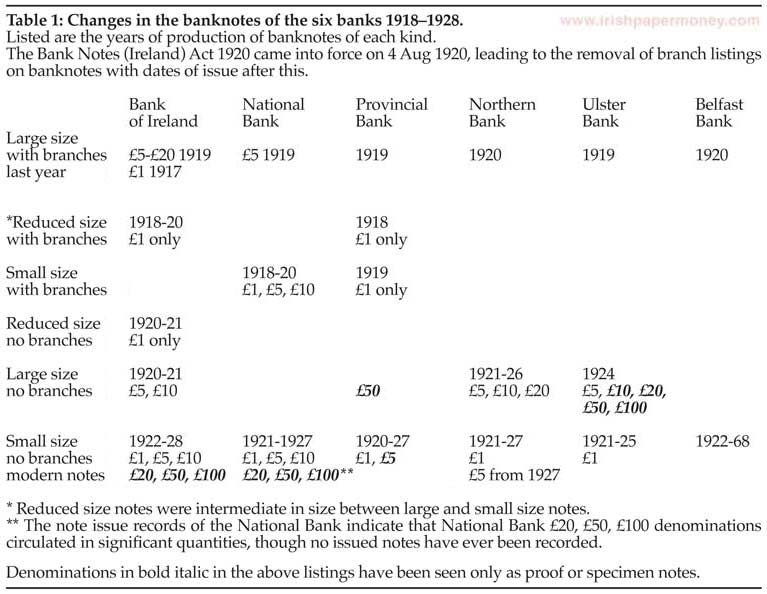
The first Bank of Ireland reduced size banknote was dated 10 Jan 1918. Prefixes were restarted at A/10. A new series, the design of these notes was very similar to that of the large size notes they replaced, with the notes being approximately half the printed area of the older issue.
The prefixes continued unbroken when the branch listings were removed from its notes in 1920, creating a new Type from a collector’s perspective, but likely not from the bank’s. The prefixes on branchless £5 and £10 notes from 1920 continued on from those on the earlier multibranch notes. All Bank of Ireland notes continued to be numbered from 000001 to 100000 per prefix during this period.
In 1922, the prefixes for £1 and £5 notes started anew with 10A and R/10 respectively, whilst the prefixes for £10 notes were continued from the earlier large size notes. There were several variations in the numbering of Bank of Ireland notes in the 1918-1925 era before the bank settled on a steady configuration for numbering.
The National Bank of Ireland was quick to move to small size notes. It’s first small size note was a £1 note dated 1 Nov 1918. The design was largely a miniature version of its large size £1 notes, and the prefix continued on from the large size notes. The National bank also made its £5 and £10 notes small size at this time, similar in size to the £1 note.
The gravure underprint colour of the £5 and £10 notes was changed from green (on all denominations of the large size notes) to brown and purple respectively.
The serial numbers on these small size multibranch £1, £5 and £10 notes continued on from the large size notes, implying that the bank did not regard the reduction in size of the note as a new issue, but a continuation of the large size series, it’s 4th General Issue. This is confirmed by the bank's burnt note records, held in the RBS archive. All three denominations employ a single letter prefix plus 5 digit number with leading zeros.
All the serial numbers were restarted when the notes were printed without branch listings, indicating a new issue, the bank’s 5th General Issue—this is reflected in the bank’s own records. £1 notes bore a prefix plus a five digit number with leading zeros. This was increased to a prefix plus six digit number from 1922. Other denominations bore a continuing number without a prefix, which started at five digits and was extended to six digits on £5 and £10 notes.
The National Bank dropped the £3 note denomination in the transition from large size to small size notes. The latest date seen for a National Bank £3 is 3 Dec 1915, which is the latest date seen for an Irish £3 note of any bank.
For the Northern Bank, no reduced or small size multibranch notes have ever been seen, though Paper Money of Ireland (2009) notes that the bank’s records show that designs were prepared and dates (1 Jan 1920, 1 March 1920) and serial numbers assigned to them.
Northern Bank Series D £1 notes dated 1 Jan 1921, small size notes with hand set signatures, were the first issue of banknotes without branches. These were issued up to 1924. Numbering was restarted on these notes, using a single letter prefix plus 5 digit number with leading zeros, commencing with letter A. The number of notes per date varied and some dates cover fewer than one prefix, with others covering more than one prefix.
In 1924 numbering was again restarted, this time with a letter over letter prefix plus six digit number, running to 100000 per date and prefix. This continued through to 1927. Printed signatures were also integrated onto the plate on these notes. There is one anomaly amongst these in the second date, where a letter over number prefix was used, before the letter over letter prefixes were reestablished. This anomalous note, with prefix A/2, between A/A and B/B is quite a rarity.
Northern Bank £5, £10, £20 notes of Series D without branches were printed as large size notes with dates in October 1921. The serial numbers on all these denominations were restarted. Only the £5 note circulated, running to three dates up to 1926. In 1927 the £5 note became small size, and remained hand signed.
All of the £5, £10, £20 notes of this issue were hand-signed. Some of the small size £5 notes and the two higher denominations were used with an overprint in 1929 in the Northern Ireland Northern Bank Overprinted issue.
The Provincial Bank of Ireland initially issued a slightly reduced size £1 note, dated 1 August 1918, which was about 10% smaller in printed area than earlier notes had been. Although only slightly reduced in size, the note incorporated a significant large scale re-design of minor features. This issue only ran to part of one prefix, V without leading zeros. It may be regarded as an interim series, as the next date £1 note of the Provincial bank was a small size £1 note of almost exactly the same design as the 1 August 1918 reduced size note. Dated 1 May 1919, it continued the V prefix of the previous design. On subsequent dates in 1919 prefixes continued as far as X, with numbers going beyond 100000. These Provincial Bank of Ireland reduced size and small size multibranch notes are both rare short-lived issues. Both are different Types in collecting terms, though the bank likely regarded them as being a continuation of the original large size General Issue that preceded them.
In 1920 the Provincial Bank issued its first new banknotes without branch listings, small size £1 notes dated 1 November 1920. These notes were the first issues of the bank to be printed on the reverse. The notes remained hand signed and restarted numbering without prefixes from (presumably) 1, with numbers apparently up to 200000. In 1921 single letter prefixes were then introduced, commencing with A. In 1922 printed signatures were introduced on the banknotes in place of hand signatures.
A proof of a small size £5 note, without branches, dated 5 November 1920 has been seen, and there are large quantities of punch-cancelled unissued remainder notes dated 5 November 1926, both with and without serial numbers, though no issued notes are known.
A large size proof in black of a £50 note without branches has also been seen, dated 25 November 1920. Proofs of the other denominations can be inferred from this.
Ulster Bank did not issue any small size multibranch notes. The bank produced designs for a series of notes without branch listings, very similar to its large size multibranch notes. Denominations of £5-£100 were large size, and the £1 was small size. Proofs of the £1 note are dated 1 June 1920. The first issued note was dated 1 Dec 1921. Some of the £5 notes were also issued, with two dates in 1924 recorded.
The bank’s notes remained payable at its two head offices, Dublin and Belfast. It is notable that the bank removed Dublin as a head office on its notes from 1926 onwards, listing only Belfast thereafter.
The Belfast Banking Company withdrew from business in the Irish Free State before it produced any design to replace its multibranch General Issue notes. The bank issued a new series of banknotes for Northern Ireland only with £1 note dates starting in 1922, and dates in 1923 on other denominations up to £100. The denominations were of varying sizes. These notes circulated throughout Ireland up to 6 May 1929, after which they circulated in Northern Ireland only.
Last known years for which large size notes were printed
Bank of Ireland: £1 (1917), £5, £10, £20 (1919), £50 (1908).
National Bank Limited: £1 (1918), £5 (1919), £10 (1918), £20 (1916). £50 and £100 were issued in small quantities, but have not been seen other than as specimens (in RBS archives).
Provincial Bank of Ireland: £1 (1918), £5 (1918), £10 (1919), £20 (1904).
Northern Bank: £1 (1919), £5 (1919), £10 (1920), £20 (1919), £50 (1918), £100 (1919). £20 notes were destroyed unissued. £50 and £100 were issued with Northern Ireland overprints only.
Ulster Bank: £1 (1917), £5 (1919), £10 (1918), £20 (1914).
Belfast Banking Company: £1 (1920), £5 (1918), £10 (1919), £20 (1916), £50, (1917).
The latest date seen on a large-sized banknote with branches is a Belfast Banking company £1 note, dated 20 July 1920. The latest recorded date of a smaller-sized banknote with all the branches on it is a Bank of Ireland £1, dated 14 April 1920, and the earliest note recorded without branches is a Bank of Ireland £1 note, dated 12 Aug 1920. There is room for one other date between these two—that date could be either on a banknote with branches, or without branches on it.
The effect of the transition from banknotes with listings of bank branches on them to branchless notes as a result of the 1920 Act more or less coincided with the partition of Ireland into The Irish Free State and Northern Ireland in 1922. Despite the political partition of Ireland, and the independence of the Irish Free State, the island continued with a currency union between the two jurisdictions, with all currency circulating freely.
The currency was secured by means of a link with Sterling, and English notes also circulated in small quantities, as did occasional Scottish notes. The business of banking continued unaffected by the political changes up until the creation of the Currency Commission Irish Free State in 1927.
Several years after the Partition of Ireland the currency circulating in Ireland changed completely with the provisions of the 1927 Currency Act in the Irish Free State. The Partition of Irish Currency resulted, with the currency circulating on the island being split between the two jurisdictions of the Irish Free State and Northern Ireland.
There is a lot of variation in the Irish banknote issues of this era. The rarest notes of this period are some of the issues from the larger banks: the Provincial Bank reduced sized £1 note (1 Aug 1918); the Bank of Ireland £5 note of 1919, each a separate Type in collecting terms; the National Bank small size £5 notes of 1919, and £1 and £10 notes of 1920 are all very rare.
Most banknotes of this era are quite scarce, with many of them being seldom seen. The exceptions to this are the Ulster Bank small size £1 notes, 1923-1926. A sizeable hoard of over a hundred of these notes in VG to VF grade turned up in the 1970s, making them relatively easy to obtain. The bank of Ireland reduced size £1 notes (1918–1921) are also relatively common, as are the bank’s small size £1 notes (1922–1928)—both were large print runs. Next easiest to obtain are small size £1 notes of the Provincial from 1923 on, and of the Northern from 1925 on. All National Bank banknotes are quite scarce.
There is a lot for collectors to pursue in the banknotes from this era. After decades of short supply, a range of these notes, including at least one example of every type and variety, appeared in auction, as some of the older collections of Irish notes were broken up. There were also some instances of previously uncatalogued types and varieties coming to light, mostly from non-collecting sources.
Original Version (2017)
Original [print] version (2017), published in Coin News as: 'The Transition of Irish Currencies, Irish banknotes 1918–1928', June 2017, p77.
References
1. Bank of Ireland Archives, Dublin.
2. Blake, R., Callaway, J. (2009). Paper Money of Ireland, 1st Ed.
3. Mac Devitt, M. (2005). Irish Banknotes. Irish Paper Money 1783–2001, 3rd Ed.
4. Mac Devitt, M. (2017). 'The 'Lady Lavery' Legal Tender Note Issue of the Irish Free State, 1928” Coin News, December 2015, p76.
5. Mac Devitt, M. (2017). 'The 'Ploughman' Consolidated Bank Note Issue of the Irish Free State, 1929–41' Coin News, August 2015, p77.
6. Moynihan, M. Currency and Central Banking in Ireland 1922–60, Gill & MacMillan in association with the Central Bank of Ireland., 1975.
7. The Banknotes (Ireland) Act, 1920, [Last accessed 19.09.2021].
8. The Bankers (Ireland) Act, 1845, [Last accessed 19.09.2021].
9. Royal Bank of Scotland Archives, Edinburgh.
The Transition of Irish Currency, Irish banknotes 1918–1928
The Partition of Irish Currency, Irish banknotes 1928–1930
Irish Three Pound Notes
Banknote Design Evolution 1824 to 1916
Contemporary Forgeries of Early Irish Banknotes, ca1800-1930
Limerick Soviet Notes
Irish World War 2 Banknote Issues
A Series Irish Ten Shilling Notes
B Series 100 Pound Note
Low Number Irish Banknotes
Irish Joint Stock Banks of Note Issue from 1783
Irish Legal Tender Note Specimens
Ploughman Scan Survey (PSS)
![]()